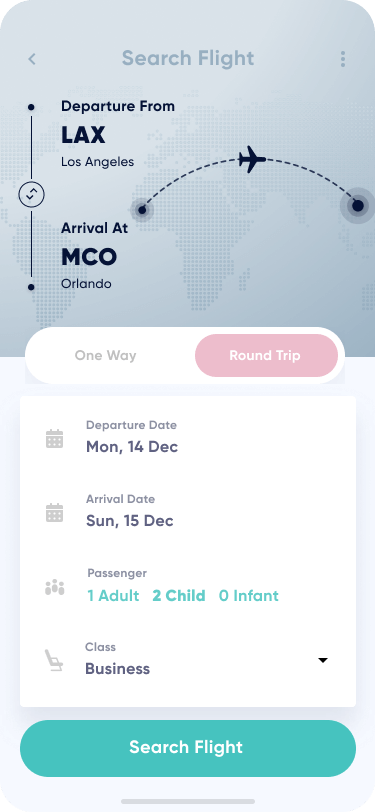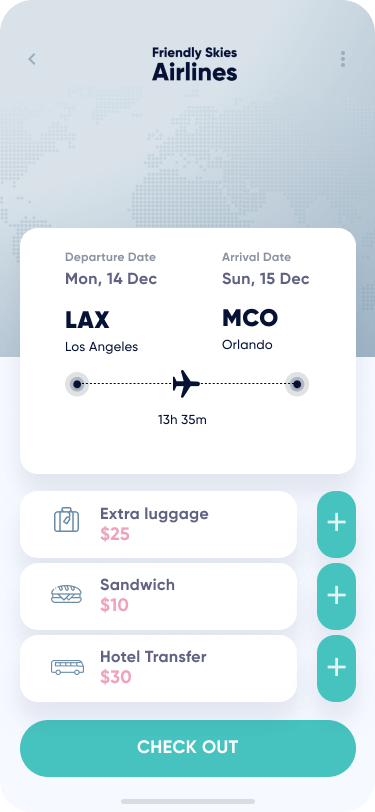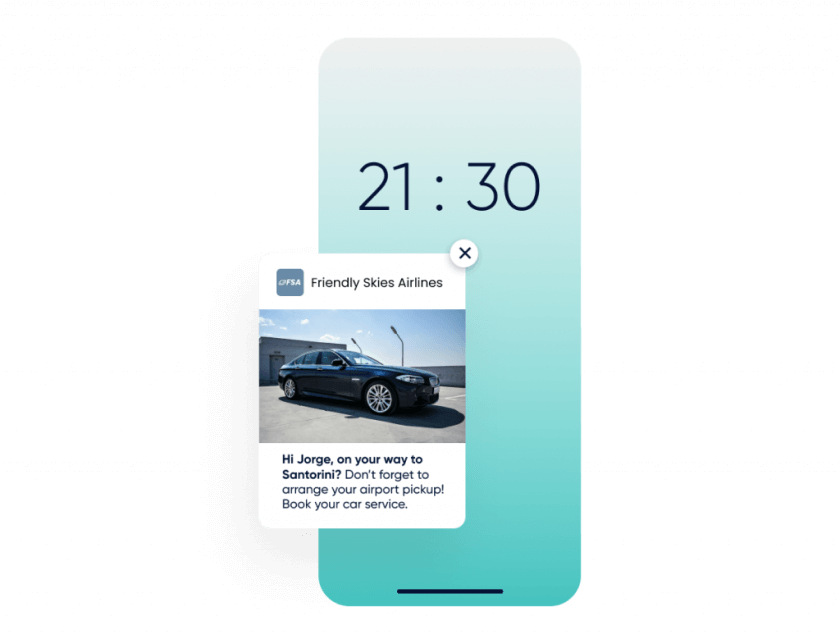REBOUND READY: Gain ancillary revenue in resurgent travel, hospitality, and leisure markets
No question. The COVID-19 pandemic hit the travel, hospitality, and leisure industry hard — really hard. According to McKinsey, global air passenger volume last August was reduced by about 64% compared to 2019.1 Forbes reports that U.S. airlines carried 60% fewer passengers in 2020.2
Hotels were hit hard, too. Real estate analytics firm CoStar states that “the hotel industry has endured its most difficult and prolonged drop in demand on record, with revenue per available room falling to $14.71 globally at the depths of the crisis.”3
Updated on May 11, 2021
The hospitality and leisure sectors in general accounted for 39% of job losses due to the pandemic.4
But there are signs that the industry is finding its feet after the “lost year” of 2020. It may even leap forward as vaccines are administered and restrictions loosen in some areas.
The American Express Travel: Global Travel Trends Report sees pent-up demand. Research across seven countries finds that 87% say having a trip planned gives them something to look forward to and 76% are creating their destination wish list. The American Hotel and Lodging Association’s 2021 State of the Industry report has more good news. It forecasts hotels will add about 200,000 operations jobs this year.6
This rebound presents digital marketers with a unique opportunity. Maybe a once-in-a-lifetime opportunity to help an industry that was knocked off its feet to come back to life and come back profitably.
One of the post-pandemic keys to profitability is ancillary services. Pre-pandemic, McKinsey reported that ancillary revenues actually exceeded annual operating profit for airlines.7 Coming out of the pandemic, add-ons and incentives from extra leg room to room upgrades, from loyalty programs to guided tours, virtually any amenity you can think of should again prove vital to the overall industry’s ability to turn a profit.
Cross sell and upsell opportunities for ancillary services are great fit for digital marketing techniques such as email marketing, push notifications, WhatsApp integrations, geofencing and more. With Insider’s tools, you can segment your audiences, predict buying behavior, and truly personalize your messages to hit your targets with the right offer, at the right time, and on the right channel.
Here’s a look at how, sector by sector.
Airlines: Up, up, and upsell away
As McKinsey points out, perhaps in no other sector are ancillary services more important than they are for air travel. If you’re an airline marketer, you know that these services aren’t limited to flight-related items like seat upgrades, trip insurance, food and beverage, and bag-check discounts. Airlines have become retailers offering everything from hotel accommodations to spa visits to credit card memberships and more through commissioned sales and partnerships.
Ancillary services offer a great way to really enhance a flyer’s experience, but you need to be able to segment your customers, predict which ones are likely to buy which offers, and then personalize those offers and recommendations at the right time — and on the right device.
One of the advantages you have is plenty of data about your audience — who they are, where they’re going, who’s going with them, flight duration, address, email, phone number, birth date, and more. This information can be used to segment your audiences and Insider’s predictive AI technology can be applied to understand what segments are likely to be receptive to what offers.
Let’s say a family of four books a flight from Portland, Maine to Orlando for a trip to Disney World. That’s a pretty long flight, and as it turns out, one with two kids in tow. When they reach the success screen for their booking, you can use Insider’s Smart Recommender to serve up a personalized overlay recommending right fit products. For example, if a family is traveling with young kids you can recommend snacks or on-flight entertainment to keep them from getting restless. Or, show them an overlay offering a discount on extra baggage handling.


As you know, purchase cycles for air travel are long. The average time it takes to purchase airline tickets can be over 100 days after a traveler first begins researching.8 Once they do book their flight, optimizing the opportunities at the success screen is critical for upsell and cross sell revenue.
Another way to do this is with mobile push notifications. It’s easy. An in-app message on your success screen asks for permission to send push notifications. All flyers need to do is click ‘allow.’
Push notifications send offers and recommendations directly to traveler’s phones while they are on the move — without a lengthy opt-in process. They are particularly helpful to airlines because mobile screens for bookings are already too cramped with itineraries and other details. Push notifications operate outside or ‘on top’ of that environment, offering a direct route for recommendations and a greater opportunity for conversions. Like reminding travelers to arrange for their ground transportation just before they take off.

You can also take advantage of your data after the trip to send personalized emails about other family-friendly destinations, including price packages, free in-flight entertainment, or added points on your loyalty program.
Insider’s predictive segmentation, personalization, and multichannel capabilities can help you develop upsell and cross sell opportunities with flyers as they move across their real and digital journeys.
Holistic hotels
The techniques and technologies used by airlines can work for hotels, too. If you’re a hotelier, you know it’s important to take a holistic view of your facilities and associated services and properties. It’s more than just rooms and rates. It’s about a comprehensive approach that creates a personalized customer experience whenever somebody stays with you.
For example, if a traveler books a room with you in Washington, D.C., you can offer discounted passes to the Smithsonian or a Capitals hockey game based on user preferences and behaviors. Chicago? Include incentives for local restaurants and taverns (they’ll be back) or for the culturally minded, a boat tour of Chicago’s architectural wonders. Insider’s digital growth tools can integrate with your hotel’s mobile app and make these recommendations at the right time as part of your app’s user experience.
Guests will begin to view your hotel as more than a just place to sleep and shower. They’ll look to you as their home away from home because you can make their stay a complete and personalized experience.
Let’s go back to D.C. for a minute and look at how another tool from Insider helps build ancillary revenue.
If a couple books a room in D.C. over a weekend, Insider’s WhatsApp extension can nudge them with personalized, in-time messages an hour after they check in. WhatsApp starts a conversation: “Do you have plans for tomorrow? If YES press 1, if NO press 2” If they choose 2, you can let them know about a special exhibition at the National Portrait Gallery. Or offer a couple’s golf outing near your property.
Each recommendation is tuned to their preferences and needs based on information available at check in.
Play Sherman Lakes. Nine or eighteen holes. Discounts available for couples and foursomes.
Tee times available now.
After their romantic getaway, you can use Insider’s personalized email capabilities to offer future room deals or upgrades along with ancillary amenities like limousine services or symphony tickets to keep them booking with you.
Right offer at the right time for OTAs
Online travel agencies (OTA) have achieved great success as the original disruptors in the travel, hospitality, and leisure industry. But the competition is getting stiffer. Google and Amazon are in the game and direct bookings with hotels are making a comeback. Pre-COVID-19, OTAs and hotels were expected to reach a 50/50 split by 2022, after OTAs having taken the initial lead.9
These factors make ancillary revenue a big deal for OTAs. If you’re an OTA, you’re fully aware, especially with the lingering effects of COVID 19, that it’s essential to maximize the value of every booking and transaction.
Research done by Insider states that the two key drivers for doing this are: getting the offer right and getting the timing right.
Getting the offer right comes down to understanding your prospects and customers. Again, Insider’s segmentation capabilities can really help you understand customers in terms of past traits, behaviors, events, purchase data, and predicted behavior. Insider’s Smart Recommender can help here, too, by enabling you to apply the right recommendation strategy for those segments, from trending products to discounts to purchased-together and more.
For example, you can use a purchased-together strategy for users you know tend to purchase tours, room upgrades, and other add-ons as part of their travel. Or you may have bookers that often travel with infants, you can offer them pricing specials for extra luggage handling that they’ll really appreciate.
As for getting the timing right, OTAs should consider touching the traveler across a booking, post-booking, pre-travel, and during-travel experience. Geofencing or location-based marketing can be a powerful ally when it comes to getting the timing right across the customer journey and channels.
Geofencing uses radio frequency identification (RFID), Wi-Fi, GPS, or cellular data to set up a virtual perimeter around a real geographic location. When the user enters the perimeter, geofencing triggers a marketing event, typically on a mobile device.10
For OTAs this is a great tool because 85% of leisure travelers decide on activities after arriving at their destination.11 Once they do, it’s the perfect time to recommend that after-flight massage, guided tour, or hiking adventure.
One Insider customer used geofencing and advanced segmentation to achieve a 128% increase in ancillary revenues. When their travelers entered the geofence near their departing airport, it was the perfect time to send a push notification reminding them to purchase discounted travel insurance.
More than airlines, hotels, and OTAs
Other sectors of the travel, hospitality, and leisure industry can take advantage of these digital growth tactics to build ancillary revenue, too.
For car rental companies, upsells can have a bad reputation. Consumers are warned to stay away from gratuitous insurance, unnecessary upgrades to a full-size vehicle, or the old “don’t worry about filling up the tank” routine.
It doesn’t have to be this way. You can truly add value to the customer experience by personalizing your offers based on real customer needs. Follow up with frequent drivers offering personalized email deals from your rewards program. Or use push notifications as they travel to let them know about lodging and leisure activities just down the road.
Destination marketing organizations (DMO) such as local tourist boards, convention and visitor’s bureaus, and private DMOs can do the same. In fact, DMOs might have even stronger connections and partnerships within their given geographical area than other travel marketers do with more distant partners.
A great first step is to create an app like the I Love New York Official Travel App. From there, you can begin to connect to everything that makes your destination special. For New York State, the Adirondacks, Niagara Falls, and the National Baseball Hall of Fame and Museum at Cooperstown are obvious choices.
With Insider’s tools you can be sure to promote the Adirondacks to the hikers that spent a weekend in the Finger Lakes last year and the baseball museum to visitors that are buying tickets at Yankee Stadium.
Ancillary revenue ready
Given the unpredictability of a pandemic, nobody can truly say what the near future holds for travel, hospitality, and leisure. But the omens are good. The New York Times recently reported that many people who have received the vaccine are booking flights and trips. Times travel reporter Tariro Mzezewa says “bookings for almost everything are up” and “travel will go beyond the road trips of last summer. Vaccinated people will be more comfortable being around other people.” In addition, in the U.S. and abroad, the notion of “vaccine passports” look to be another key to a travel revival, says the Times.12
Marketers understand that there is no turning back the clock. Attitudes, outlooks, learned behaviors, and maybe some amount of travel skittishness may hold out. Whatever the next phase may be, ancillary revenue is not likely to lose its potency. The right — and truly optimistic — play for digital marketers is to get ready for the rebound with predictive segmentation, advanced personalization, and multichannel maneuverability now.
Ready to rebound?
See for yourself how Insider’s Growth Management Platform can help you understand your audiences, predict behaviors, and deliver hyper-personalized experiences and journeys across channels. Request a demo.




















